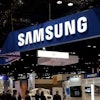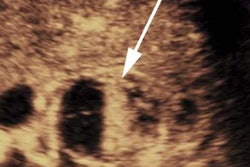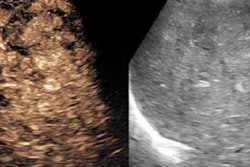
Contrast-enhanced ultrasound (CEUS) is a safe and likely cost-effective imaging option for pediatric patients, often obviating the need for MRI and CT, according to a study published in the February issue of the American Journal of Roentgenology.
A team from King's College London in the U.K. retrospectively reviewed the records of more than 300 pediatric patients and found no immediate adverse reactions to contrast ultrasound. While there were two delayed reactions attributed to contrast ultrasound, these were asymptomatic.
On the positive side, the use of contrast ultrasound avoided 97 MRI examinations and 71 CT exams, saving thousands of dollars and offering a number of important benefits for these vulnerable patients, according to the researchers.
"Using [CEUS] allows reduction in the ionizing radiation associated with CT and in the gadolinium contrast administration, sedation, and anesthesia sometimes required for MRI," wrote the group led by Dr. Gibran Yusuf (AJR, February 2017, Vol. 208:2, pp. 446-452).
Avoiding radiation, saving costs
Contrast ultrasound has drawn attention as a less-expensive and radiation-free alternative to CT and MRI in pediatric patients. While CEUS has received regulatory approval for pediatric hepatic use, it still remains off-label for a range of other pediatric applications, according to Yusuf and colleagues.
As a result, the researchers sought to analyze their institution's pediatric contrast ultrasound practice to document its areas of use and the prevalence of adverse incidents. In addition, they wanted to explore the implications -- including the potential financial benefits -- of pediatric CEUS in terms of avoiding the need for CT and MRI exams.
The group retrospectively reviewed the electronic patient records of 305 pediatric patients who underwent CEUS at their institution between January 2008 and December 2015. The patients consisted of 187 boys and 188 girls, with an age range of 1 month to 18 years.
All CEUS studies were performed by one of three operators who had 21, 18, and 10 years of CEUS experience, respectively, using an Acuson S2000 or S3000 (Siemens Healthineers) or RS80A (Samsung Medison) scanner with a low-mechanical index technique after optimized grayscale and color Doppler imaging. Depending on the body part being studied, the patients received 0.1 mL to 4.8 mL of a sulfur hexafluoride microbubble contrast agent (marketed by Bracco as SonoVue in Europe and Lumason in the U.S.), with a median dose of 2.4 mL.
Of the studies, 147 (48.2%) were for characterizing liver lesions and 113 (37.1%) were for trauma. The remaining 45 scans (14.8%) were for renal, vascular, and intracavitary assessment.
Few adverse events
None of the patients experienced immediate adverse reactions from their contrast ultrasound study. Two patients (0.7%) had delayed adverse reactions: transient hypertension and transient tachycardia.
"Neither was symptomatic, and both were deemed not due to the underlying disorder," they wrote.
The researchers then used prices from the U.K. National Institute for Health and Care Excellence (NICE) analysis to compare the utilization costs of a contrast ultrasound scan with those of CT and MRI. A CEUS study was deemed to cost $74 per examination, while CT cost $168 and MRI cost $274.
After reviewing the records, the researchers judged that the CEUS exam avoided the need for 97 MRI examinations as well as 71 CT exams -- representing an aggregate dose savings of approximately 376 mSv. By saving $74 over CT and $180 over MRI, CEUS yielded potential cost savings of $15,792 in the study group, according to the researchers.
Using CEUS to characterize liver lesions avoided the need for MRI in 73 of the 97 cases. The analysis did not include costs for administering a general anesthetic, so the cost savings would even be higher in those cases, Yusuf and colleagues also noted.
Follow-up with CEUS in trauma patients with single-organ injuries would also reduce costs by $74 per examination over CT.
However, "these children often need serial examinations with exposure to a cumulatively higher degree of ionizing radiation and potentially nephrotoxic iodinated contrast medium," they wrote.
Contrast ultrasound added no more than five minutes to the total length of an ultrasound study, and it was still shorter than an MRI study, according to the researchers.
"Although a CT examination is quick, the length of recovery and previous sedation or anesthesia often required render CEUS quicker overall," they wrote.
Barriers to CEUS
The team acknowledged that more widespread use of contrast ultrasound is hindered by the same issues that hamper conventional ultrasound, notably adverse habitus, bowel gas, calcifications, and lack of patient cooperation.
"However, a CEUS examination can be tailored to the individual patient and performed in the department or at the bedside," they wrote. "CEUS can be repeated as needed without patient morbidity, and the real-time nature of ultrasound allows observation at many stages of the examination, unlike the snapshot approach of CT and MRI."
The researchers concluded that their study shows contrast ultrasound to be safe and cost-effective for use in children.
"By avoiding further imaging, CEUS contributes to reducing the dose of ionizing radiation, the risks of both iodinated and MRI contrast media, and the risks associated with sedation for MRI," they wrote.




















